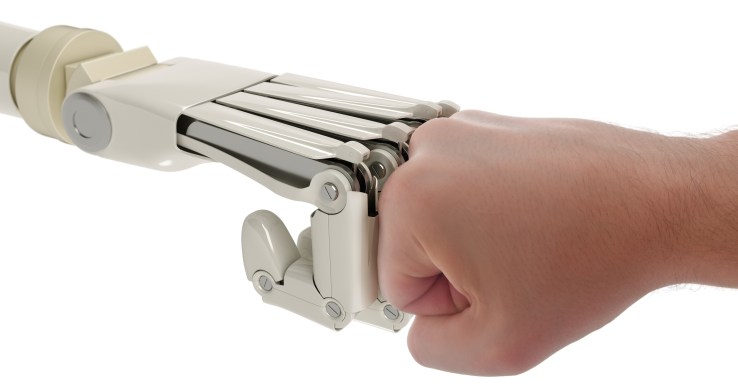Dexterous industrial manipulators and industrial vision have roots in advanced robotics work conducted in artificial intelligence (AI) laboratories since the late 1960s. Yet, even more than with AI itself, these accomplishments fall far short of the motivating vision of machines with broad human abilities. Techniques for recognizing and manipulating objects, reliably navigating spaces, and planning actions have worked in some narrow, constrained contexts, but they have failed in more general circumstances.
The first robotics vision programs, pursued into the early 1970s, used statistical formulas to detect linear boundaries in robot camera images and clever geometric reasoning to link these lines into boundaries of probable objects, providing an internal model of their world. Further geometric formulas related object positions to the necessary joint angles needed to allow a robot arm to grasp them, or the steering and drive motions to get a mobile robot around (or to) the object. This approach was tedious to program and frequently failed when unplanned image complexities misled the first steps. An attempt in the late 1970s to overcome these limitations by adding an expert system component for visual analysis mainly made the programs more unwieldy—substituting complex new confusions for simpler failures.
![Mars Rover Research Project [Credit: © MIT, Artificial Intelligence Laboratory]](https://i0.wp.com/media-2.web.britannica.com/eb-media/74/65774-004-6505892A.jpg)
In the mid-1980s Rodny Brooks of the MIT AI lab used this impasse to launch a highly visible new movement that rejected the effort to have machines create internal models of their surroundings. Instead, Brooks and his followers wrote computer programs with simple subprograms that connected sensor inputs to motor outputs, each subprogram encoding a behaviour such as avoiding a sensed obstacle or heading toward a detected goal. There is evidence that many insects function largely this way, as do parts of larger nervous systems. The approach resulted in some very engaging insectlike robots, but—as with real insects—their behaviour was erratic, as their sensors were momentarily misled, and the approach proved unsuitable for larger robots. Also, this approach provided no direct mechanism for specifying long, complex sequences of actions—the raison d’être of industrial robot manipulators and surely of future home robots (note, however, that in 2004 iRobot Corporation sold more than one million robot vacuum cleaners capable of simple insectlike behaviours, a first for a service robot).
![Pebbles [Credit: © MIT, Artificial Intelligence Laboratory]](https://i0.wp.com/media-2.web.britannica.com/eb-media/12/62112-004-2DDEC392.jpg)
Meanwhile, other researchers continue to pursue various techniques to enable robots to perceive their surroundings and track their own movements. One prominent example involves semiautonomous mobile robots for exploration of the Martian surface. Because of the longtransmission times for signals, these “rovers” must be able to negotiate short distances between interventions from Earth.
A particularly interesting testing ground for fully autonomous mobile robot research is football(soccer). In 1993 an international community of researchers organized a long-term program to develop robots capable of playing this sport, with progress tested in annual machine tournaments. The firstRoboCup games were held in 1997 in Nagoya, Japan, with teams entered in three competition categories: computer simulation, small robots, and midsize robots. Merely finding and pushing the ball was a major accomplishment, but the event encouraged participants to share research, and play improved dramatically in subsequent years. In 1998 Sony began providing researchers with programmable AIBOs for a new competition category; this gave teams a standard reliable prebuilt hardware platform for software experimentation.
While robot football has helped to coordinate and focus research in some specialized skills, research involving broader abilities is fragmented. Sensors—sonar and laser rangefinders, cameras, and special light sources—are used with algorithms that model images or spaces by using various geometric shapes and that attempt to deduce what a robot’s position is, where and what other things are nearby, and how different tasks can be accomplished. Faster microprocessors developed in the 1990s have enabled new, broadly effective techniques. For example, by statistically weighing large quantities of sensor measurements, computers can mitigate individually confusing readings caused by reflections, blockages, bad illumination, or other complications. Another technique employs “automatic” learning to classify sensor inputs—for instance, into objects or situations—or to translate sensor states directly into desired behaviour. Connectionist neural networks containing thousands of adjustable-strength connections are the most famous learners, but smaller, more-specialized frameworks usually learn faster and better. In some, a program that does the right thing as nearly as can be prearranged also has “adjustment knobs” to fine-tune the behaviour. Another kind of learning remembers a large number of input instances and their correct responses and interpolates between them to deal with new inputs. Such techniques are already in broad use for computer software that converts speech into text.
#robotics-2, #science






![robot suits [Credit: Contunico © ZDF Enterprises GmbH, Mainz]](https://i0.wp.com/media-2.web.britannica.com/eb-media/44/179544-049-559E6B0B.jpg)

![Mars Rover Research Project [Credit: © MIT, Artificial Intelligence Laboratory]](https://i0.wp.com/media-2.web.britannica.com/eb-media/74/65774-004-6505892A.jpg)
![Pebbles [Credit: © MIT, Artificial Intelligence Laboratory]](https://i0.wp.com/media-2.web.britannica.com/eb-media/12/62112-004-2DDEC392.jpg)
![AIBO [Credit: Courtesy of Sony Electronics Inc.]](https://i0.wp.com/media-2.web.britannica.com/eb-media/88/65188-004-1BAEC6C2.jpg)
![robotics: industrial robot at a factory [Credit: © Index Open]](https://i0.wp.com/media-2.web.britannica.com/eb-media/31/100531-004-DE60C750.jpg)
![bacterial genetics: use of robots [Credit: University College Cork, Ireland (A Britannica Publishing Partner)]](https://i0.wp.com/media-2.web.britannica.com/eb-media/95/183295-049-FB6643CE.jpg)
![humanoid robot [Credit: American Honda Motor Co., Inc.]](https://i0.wp.com/media-2.web.britannica.com/eb-media/13/99513-004-713557B6.jpg)
![“Metropolis”: still with Abel, Helm, and Klein-Rogge from “Metropolis” [Credit: From a private collection]](https://i0.wp.com/media-2.web.britannica.com/eb-media/56/80056-004-FCCAED29.jpg)
You must be logged in to post a comment.